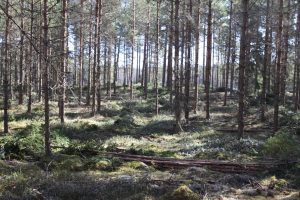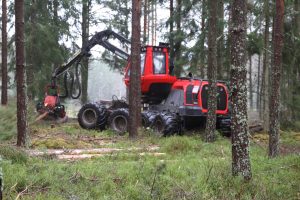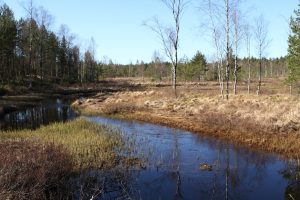Eventually we have reached the point where the forest owner can actually gain some profit from the forest by doing commercial thinning. A forest stand that has been properly managed from the start, could now start to pay off.
Commercial thinning
The proper time for commercial thinning is decided by the height of the trees, the site fertility and of how dense the stand is. The purpose of thinning is to create a better basis for the best trees by removing the damaged ones and those with less possibilities to become trees of good quality. Normally you do two thinning’s before the final felling of a stand. Sometimes, one is enough.
By thinning, you can create a suitable mix of tree species, due to the soil conditions and targets for your forest. You can make the stand more resistant against wildfires by saving a certain volume of hardwood species in a coniferous forest. Also, other types of damages can be prevented by thinning, as for an example snow breakage and windthrow, as thinning stabilizes the trees left standing.
The growth of the stand does not increase after a thinning. However, the value of the stand increases as the trees left standing gains more volume and better quality. The costs for the final felling will be lower and, in some cases, it could even be possible to do the final cut earlier if the stand has been properly thinned.
Most thinning’s gives a financial surplus. The only exception is a first thinning that hasn´t been properly pre-commercially thinned.
As good as all commercial thinning’s in Sweden are made by harvesters where the operator chooses what trees to remove.
First commercial thinning
If the stand has been properly thinned with pre-commercial thinning (PCT), as we wrote about in Forestry #4, the first commercial thinning should take place when the trees are 12 – 14 meters high. It is crucial not to do the first thinning too late. If it´s done too late there is a big risk that the stems have become long, very thin and unstable which make them sensitive for snow breakage and windthrow after the thinning.
The principle is the same as for thinning in general; Remove the damaged trees first. Then decide what stems that should be left until the final cut. Give them the best possible prerequisites to develop by removing other trees that have less possibilities and that disturb the main stems. This normally means that you remove smaller trees that have less chances to gain size and quality.
Second commercial thinning
The second commercial thinning could take place when the tree height is approximately 20 meters. Just as in first thinning there is a risk that the forest will be sensitive for windthrow and breakage due to snow after a thinning if you wait too long to do it.
Again, the purpose of the action is mainly to create an as valuable stand as possible for the final felling. The method is the same; Remove damaged trees. Move on by making life as easy as possible for the main stems. If you have done your job properly you have chosen the main stems already in the first pre-commercial thinning and managed them along the way.
The strip roads that were used in the first thinning will be used again in the second one.
Risks with commercial thinning
Machines
Bringing heavy machines into the forest starting to remove trees that has been standing for 25 – 50 years cannot be made without risks. The most obvious risk is that the machines damage the trees left standing, and their root systems. Such damages can cause fungal infections such as root rot and blue stain. This can be prevented by using brush as ground protection for the machines to operate on. In wet conditions the machines can be equipped with tracks or logs can be used as ground protection.
The machines can also cause environmental, cultural and social damages. They can e.g. run over items that are supposed to be left, such as bushes or parts of stems. They can cause deep tracks in the soil or damage cultural items like old building foundations or relics.
As for the social values, when operating close to towns and villages etc. there could be walking-, jogging- or skiing paths that, according to certification, are not allowed to be damaged.
More on the environmental, cultural and social issues below.
Wind and snow
Another effect of thinning is that you open up for the wind to come through which could cause damages shortly after a thinning, before the stems have become thicker and more resistant. Also, a big amount of heavy snow can cause damage at this time.
If the forest has been thinned properly from the start – pre-commercial thinning, one or two times, with a good choice of main stems – the risks reduces significantly.
Environmental, cultural and social concern
Biodiversity has become a natural expression in Swedish forestry. Over 100 years of industrial forestry has disrupted the balance of nature which have led to some species being favored, others disadvantaged and even extinct. Since the early 90´s Swedish forestry is trying to recreate the balance, without disturbing the production of raw material to the forest industry too much.
In every action that is made in the forest, this has to be taken into consideration. Already mentioned here above is to mix the coniferous forests with hardwood species to get mixed forest and humus layer. Water breaks and slopes shall be protected zones where mainly hardwoods of as many species as possible are left standing. Also, waterlogged areas shall be protected. A certain amount of dead wood, trees or parts of trees, in different stages of decay shall be left in the forest.
As for cultural and social issues, no landmarks or relics should be damaged. Relics are valued differently due to how old and rare they are. In the worst case, both landowner and machine operator could end up in jail if damaging such items. Social issues could be, as mentioned above, recreation paths of different kinds that are not be damaged. Keep in mind that in Sweden everyone is allowed to visit the forest, also private owned ones, to walk, jog, pick mushrooms, etc.
Rules and regulations around this are stated and controlled by FSC (Forest Stewardship Council) and PEFC (Program for the Endorsement of Forest Certification) who also certifies Swedish forestry. Contractors and companies who are active within certified forestry have to be certified by at least one of those organizations.
Logging equipment for thinning
Here are two films showing different kinds of logging equipment for thinning. One modified farmer´s tractor as harvester, and one professional harvester.
Sources: skogskunskap.se, Swedish Forest Agency
Photos and films: Per Jonsson














